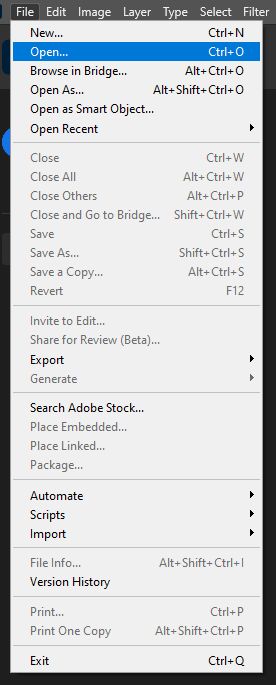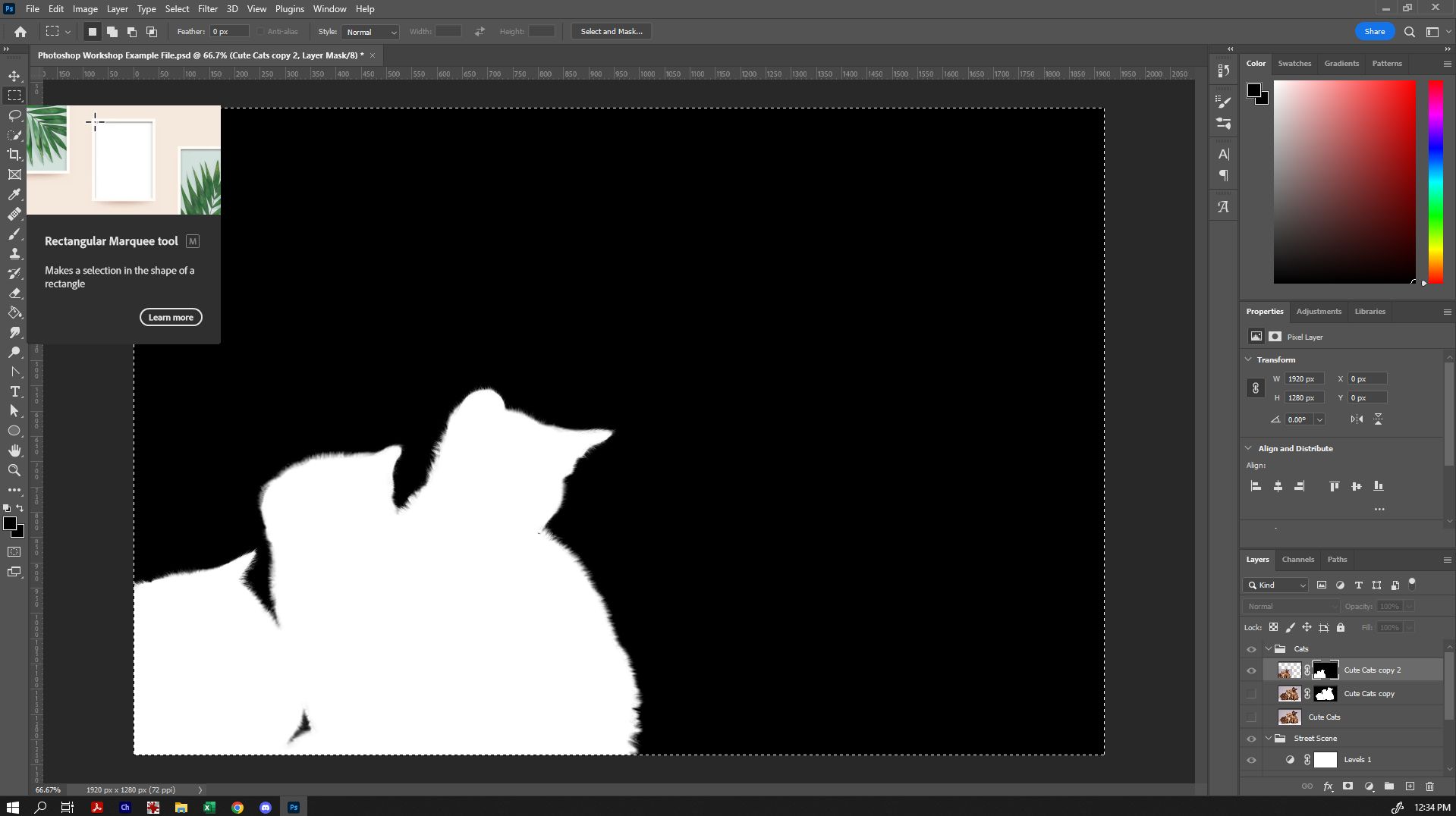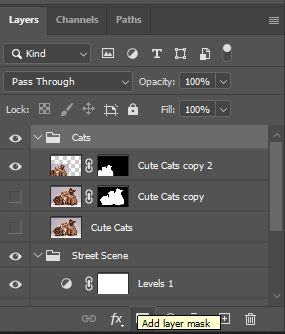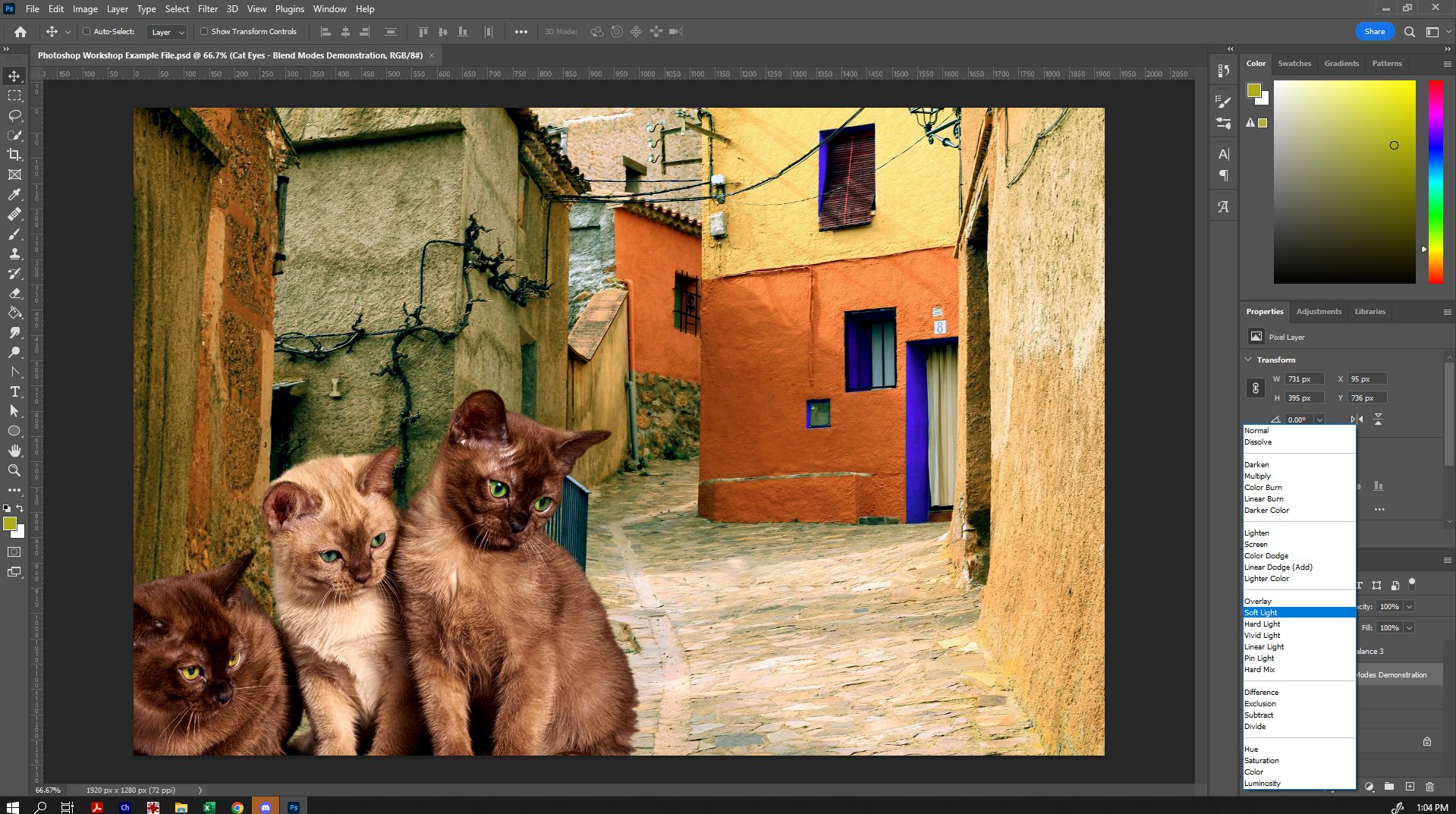101 - Intro to Photoshop - V.2
Example Image Goes here
Kat Johnston, November 23, 2022, currently in the process of being updated.
Revelopment by Waldemar Jenek 2024 Session Plan
Updated Slides by Ellie Dumigan 2025
Acknowledgement
We acknowledge Aboriginal and Torres Strait Islander peoples and their continuing connection to land and as custodians of stories for millennia. We respectfully acknowledge the land on which we all meet today, and pay our respects to elders past, present and emerging.
Summary
Have you ever wanted to retouch or edit the colours of a photo? Or add several images together into one? Learn the basics of Adobe Photoshop in this skills development workshop. Photoshop is an industry standard program for editing photos and raster graphics and for creating digital art.
101 skills development workshops give you the basic skills you need to start your new creative journey. Each workshop is delivered by an experienced facilitator and no prior experience required, just basic computer skills, a willingness to learn and a bit of patience.
Skills Introduced
- Understanding Raster Graphics
- Opening your File/Creating New Files
- Navigating the Workspace
- Layers
- Adjustment Layers
- Content Aware Fill
- Basic Masking/Making Composites
- Neural Filters
- Finishing Your Image
- Saving Your Images (File Formats)
Tools and Preparation
Software required: Adobe Photoshop.
Health & Safety
Running this workshop at The Edge?.. You should familiarise yourself and your participants with:
- DML Risk Assessment
Preparation
Before the workshop you will need to sign up for an Adobe Account so that you can sign into Adobe Creative Suite on arrival to the workshop.
Workshop Walk through
Understanding Raster Graphics
On the left, you can see a raster graphic. On the right is a vector. You are likely very familiar with raster images already - if you've ever taken a photograph on your phone, you've produced a raster image!
 |  |
| Raster/Bitmap | Vector |
| A raster image (for example a photo taken on a digital camera) is made up of thousands of little squares of colour called pixels. If you take a raster image and stretch it to be larger than its original size it will 'pixelate' and lose quality. | Whereas in vectors we can make our image as big or small as we like and it will never lose the crisp lines, this is because vectors are not made of pixels, instead they are made up of lines described by mathematical equations (thankfully we don't need to know the maths, the computer works that out for us!). |
Because we are using Photoshop for photo manipulation today, we will be working with raster graphics.
Image Resolution
Because raster graphics are constrained by the pixel information within them, it is best to work with the highest quality image possible when doing editing - you can always scale down, but scaling up is not possible without quality loss.
Standard image resolutions are:
- For Screen: 72 dpi
- For Standard Print: 300 dpi
- For High Quality Print: 600 dpi
- For Very High Quality Print and Small Text: 1200 dpi
DPI stands for 'Dots per Inch'. Sometimes PPI (Pixels Per Inch) is used instead.
Colour Modes
There are two colour modes we will typically use for images:
- RGB (Red, Green, Blue) - an additive colour mode for images intended to be displayed on a screen or reproduced with light.
- CMYK (Cyan, Magenta, Yellow, Black) - a subtractive colour mode for images intended for printing with ink or replicated with pigment.
RGB is typically more vibrant than CMYK, as it is produced with light rather than pigment. It is possible to convert an image file from one colour mode to the other, however it is advisable to design using the correct colour mode from the outset if possible.
Opening your File/Creating New Files
Let's start with downloading the source images we'll use today:
- (Illustrated front cover from The Queenslander, January 2, 1936 (no date).)
- (Ladies boxing at the beach (no date).)
When they open in a new window, simply right-click and save them to your computer.
All images were sourced using One Search. If using One Search to find suitable files, you can filter your results by 'Condition of Use' so that it shows only 'Free to Use' resources.
If creating a new file from scratch, you could go to 'File' and click 'New', then select from the variety of presets available (eg, A4) or choose a custom option.
For today, let's create an A4 file in a RGB colour space, and set the orientation to landscape. Hint: it's a good idea to check what units of measurement the pre-set is using, and change it to one you are familiar with!
To open files in Photoshop, go to 'File', and 'Open'. Select your files to open them. You can open both at once by selecting the first, then holding down the 'CTRL' key as you click the other files you wish to open. Open up the two files we have downloaded, so that you have them handy.
Additional images you may want to play with, if you're feeling more advanced:
- (Agnew, G. (Garnet G. (no date) Illustrated front cover from The Queenslander, January 17, 1929.)
- (Illustrated front cover from The Queenslander, November 5, 1936 (no date).)
- (Beach-goers at Main Beach, Southport, Christmas, 1931 (no date).)
Navigating the Workspace
Now that we have a new file, let's have a look at our workspace:
- The Menu Bar shows the File, Edit, Image, and other menus that give you access to a variety of commands, adjustments, and panels.
- The Options bar (beneath the menu bar) displays a range of options for the tool you are currently working with. When you change tools, the options here will change.
- The Tools panel (on the left) contains tools for editing images and creating artwork. Some tools show a small triangle in the bottom right-hand corner - this indicates that related tools are hidden underneath what is currently shown. To access related tools in a group by clicking and holding a tool in the panel.
- Panels (on the right) include Color, Layers, Properties, and other panels that contain controls for working with images. You can find the full list of panels under the Window menu, but today we'll primarily be working with 'Layers' and 'Properties'.
- The Document Window (in the middle) displays the file you’re currently working on. Multiple open documents show up in tabs in the Document window. If you want, you can click and drag on a tab to separate it, so that you can view more than one document at the same time.
Resizing Elements
Let's make our ladies at the beach a more suitable size for our canvas. With the 'move' tool selected (the top in your toolbar), grab a corner and drag the image smaller. By default, it will maintain the aspect ratio of the image - if you want to change that, you can hold down shift while you drag. (We're going to keep everything in proportion this time though!)
Layers
By default, when creating a new file, the only layer you will see is a 'Background' layer.
Let's add the 'Ladies at the Beach' file as a layer in our new file by dragging it onto our working file using the 'move' tool.
By default, it give you a layer name like 'Layer 1'. Naming your layers is a great way to keep organised! To rename your layer, either double click the name (or right click, and choose rename) and give it a more descriptive name.
To delete a layer, simply right-click the name of the layer and select 'Delete Layer', or click the bin icon in the bottom right-hand corner.
Layer Organisation
- To turn on and off layer visibility, click the eye symbol beside the layer.
- To change the order of layers, click and drag the layer up and down - layers at the top will sit over layers on the bottom.
- To organise layers into groups, click the folder symbol at the bottom of the layers panel to create a new folder. You can then drag layers into that folder. Organising your layers this way can be very helpful, as folders allow you to affect multiple layers at once, and can help you navigate between layers easily with very complicated images.
Hot Tip: When creating a new layer or adjustment layer, it will appear immediately above the one you currently have selected in the Layers panel.
Adjustment Layers
Adjustment layers allow you to make nondestructive adjustments to the colors and tones to the layers beneath it, without permanently changing the pixels in the image. Adjustment layers can be altered at any time without causing a permanent change to the layers underneath them.
To access adjustment layers, click the circle at the bottom of the Layers panel, and select the adjustment layer you'd like to use.
Some adjustment layers to note are:
- Brightness/Contrast: simple adjustments to brightness and contrast.
- Levels: adjusts the tonal range and colour balance of your image - it has more fine-tuned control than Brightness/Contrast.
- Curves: where Levels adjusts the tones/colour balance globally, Curves gives you even more fine-tuned control.
- Vibrance: allows you to boost duller colours - it only affects the less saturated parts of the image, while leaving the already-saturated areas as they are.
- Hue/Saturation: changes the overall colour of your image. 'Hue' changes the colour, and 'Saturation' changes the intensity of the colour.
- Colour Balance: changes the overall mixture of colours in the image - works very well for colour correction.
- Selective Colour: allows you to remap colours - eg, changing reds to yellow, or blue to purple.
When you select any of these adjustment layers, a 'Properties' panel will appear, allowing you to fine-tune your adjustment.
Just some simple adjustment layers can make a real difference to an image - from simply correcting white-balance to changing the entire mood of an image. For now, let's just play with brightness/contrast. Try turning on and off your adjustment layer to see the before and after!
Content Aware Fill
Photoshop has a range of tools that can make editing images a lot easier than it used to be - one of those is Content Aware Fill. Let's remove the person on the left.
First, ensure that the 'Ladies at the Beach' layer is selected. Let's duplicate that, so that we have a back-up of our original before we start work on it. Right-click on the layer, and select 'Duplicate' from the menu.
Then, use the 'Lasso' tool to draw around the woman on the left, so that it selects that portion of the image for you. The lasso tool is a freehand masking tool - if you do not see it immediately, click and hold over the appropriate button to see the other options available for that tool.
You do not need to be precise, but get as close as you can to the edge of her shape without going over.
Once you're happy with your selected shape, go to 'Edit' and select 'Content Aware Fill'.
Doing so will bring up the Content Aware Fill options. From there, you can see a preview of the finished result, see an overlay of where the artificial intelligence is using to fill the area as shown by the green overlay (you can adjust this with the selection tool at top left) and change other fill settings. Experiment until you've found a fill that you think works best, and since we've already got a back-up of our original, we can select for it to output to the current layer.
You can see here that I deselected some of the areas that weren't of the correct texture, so that the artificial intelligence has a better idea of the texture we're trying to replicate. Holding down 'Alt' will allow you to switch back and forth between adding and erasing (as indicated by the + or -).
Keep an eye on the preview on the right, to see how your selection changes the final result, and play around until you're happy with how it looks. It doesn't have to be perfect - we're going to come back later and put something in that area anyway!
Because we made a duplicate of the original, we can select the output as 'current layer', so that the original image and the filled area are already merged into one.
If we wanted to, we can do some additional adjustment with tools such as the healing tool, patch tool, and clone stamp, but for today, we'll leave it at that. Click outside of the selected area to deselect your mask, and return to using the 'move' tool.
Try turning on and off the visibility of your newly filled layer, and compare it to the original!
Filters
Filters are functions within Photoshop that allow you to manipulate your images in very specific ways. Photoshop also has something called Smart filters, which are non-destructive edits and are applied to Smart Objects. Smart filters will be stored in the Layers panel for easy changes to be made. (Today we won't work with smart objects, just regular layers).
Filters can be found under the Filter Menu. You can apply a filter to the entire layer, to do this ensure you have the full layer selected. You can apply a filter to a section by only having this area selected using the selection tool. Smart filters can only be applied to a Smart object/s that are selected.
Neural Filters
Neural filters use machine learning to quickly and easily change the image - eg, to colourise our photo.
To access neutral filters by clicking on the filters > neutral filters.
This will open the Neural Filters panel, to view all the available filters then select All filters, if a filter as a cloud icon next to it this means it will need to be downloaded before it can be used. Click on the icon to download the filter. Toggle on your chosen filter. Once turned on you can then make adjustments via the options panel on the right. You can preview the changes from the filters by clicking the preview button in the lower left hand. You can also reset any applied filters by clicking on the back arrow that appears in the options tab. (If you hover over it, it will say “Reset parameters”. Click ok to save the selection or cancel to exit. Saving the output as a new layer will allow for further non-destructive editing or for this example save out as a New Layer Masked.
Let's try using the 'Colourise Image' neural filter to colourise our 'Ladies at the beach' image.
You can select from any of the pre-determined profiles as a starting point.
You can either output the colour data combined with your layer, or as a 'colour' layer. By doing this, rather than changing the colour of the layer itself, you're putting that information in its own layer, which affects the layers below it.
This can be quite helpful to cleanly select and change colours later on down the line as needed.
Basic Masking/Making Composites
We've created a nice base now for our composite image. In general, when deciding on images to composite together, there are a few things to keep in account:
- Are your images of a comparable resolution?
- Are your images of a comparable level of detail?
- Is the lighting suitable across your various components? (Eg, will the light-source look consistent when they are put together?)
If you're going for a more stylistic/obviously photoshopped look, these questions may not be as much of a concern - however if you're aiming for something more photorealistic, they're something to keep in mind. Today. we're not looking for a flawlessly realistic look. We're going to make a runner on The Queenslander cover look as if they are running through the beach scene.
First, we're going to want our runners to be facing the opposite direction (since we want to put one on the left side of our final image.) Open up your The Queenslander cover, and go to 'Image', 'Image Rotation' and select 'Flip Horizontally'.
Today, we're going to use Object Selection tool to quickly isolate and cut around the shape we want from the cover. While the object selection tool does not always produce perfect results first time, it can be a great place to start. Because we are using a clean image with clear colour delineation between areas, the object selection tool should produce a fairly clean result.
If you can't see the object selection tool specifically, it may be located underneath another tool in the toolbar.
With the object selection tool selected, hover over the object you want selected (one of the runners), and it should show highlighted in pink. Click to confirm that selection. If it is having trouble finding the full object (and is maybe selecting just a component part), try dragging a box around the whole object you would like it to contain. You can refine that selection further if needed, using some of the fine tuning tools, but for today, that should be good enough.
Rather than simply cutting out that specific shape from the background, we're going to use a mask. Masks are helpful, in that we can make further adjustments to the selection without destroying the original image - you can always go back and add in or remove areas of the mask, to reveal or hide the original image below. To make a mask from your selection, simply select the mask icon from the bottom of the layers panel (it's the rectangle with the circle over it).
As you can see, where the mask is black, it hides what is underneath - where it is white, it reveals what is underneath.
From here, we can drag that layer onto our working document, above all other layers. Remember, if you place it underneath the colour layer, the colours of that image would be altered too! Resize it so that it fits in nicely.
As you can see, our object selection was not perfect - we can make a few adjustments to remove some of the added details that we don't need. If we double-click our mask layer, it should give us an option to enter the masking layer and make adjustments. I like to select the red overlay from the options to make it easier to see where is being masked and revealed.
From there, we can zoom in and using our paint brush (with either + to add or - to minus areas of our mask), refine our selection and either add or remove the sections we wish to.
Finishing Your Image
You will notice that the mask on your smaller cats layer now has a lot of white around where the original borders of that image are. In masks, where there is white, we can see - where there is black, it will not show. Let's make it so that the mask is covering the rest of the area, because we'll use this mask for additional adjustment layers.
To select the mask, hold down 'Alt' as you select the mask area of your layer. This will let you easily see what the mask is and isn't showing.
Paint in the remaining white area around the cats with black using the paintbrush tool (or a combination of the fill and paintbrush tool).
From here, we can do something very cool: we can copy that mask, and put it on the folder, so that anything we put in that folder will only affect the cats. To do so, use the rectangular marquee and drag it over the mask, and then copy (ctrl-c, or 'Edit' and then 'Copy').
Alt-click the mask again, so that we exit the mask mode. Then select the 'Cats' folder we made earlier, and click the rectangle in the bottom of the layers panel to create a layer mask on the folder.
Then we can enter the mask we just made (Alt click the mask layer), and paste the mask from earlier (ctrl-V, or 'Edit' then 'Paste').
Alt-click the mask layer to view everything properly again.
Now anything you put in the cats folder (including adjustment layers!) will now only apply to the cats! This allows you to refine them further to blend into the scene more seamlessly - eg, you might want to adjust their contrast or colours to more suitably (or unsuitably) match the scene.
When you're happy with your result, you can stop there, although there is one last touch that can bring everything together nicely - add an additional adjustment layer (or two) on top of everything else to help unify the colours. In my final file, I also created a new layer and painted over the eyes using the paintbrush tool, and then used the 'Soft Light' blend mode on that layer. This made the colours I painted in semi-transparent in a very realistic way over the eyes to make them stand out!
Experiment! Have a play with adding in another photo, or using shapes, the paintbrush and the text-tool to add different elements. Here is an example composite image and the three photos that were used to create it side-by-side:
Saving Your Images (File Formats)
When saving your images, there are a number of formats available, from the standard Photoshop file format, to a number of other raster image types:
- .psd is the standard Photoshop format. When you save in this file format, you can pick up exactly where you left off. This file type can only be read by Photoshop.
- .tif is intended for high quality images with minimal loss of image data. The file format is typically very large as a result. Primarily used for printing.
- .jpg is popular because of its ratio of quality to file size. It uses image compression to pack as much information into the smallest file size, and you can adjust the level of compression within the save options. High quality .jpgs can be used for printing also.
- .png is primarily for screen display. The format also supports transparency.
- .gif is primarily used for screen display. The format also supports transparency. (You can also create animated gifs in Photoshop too!)
When saving your file/s, consider their intended purpose and pick your file type accordingly. It is always recommended that you save a .psd version so that you can go back and make changes should you ever want to, as all other raster file types will 'flatten' all of your layers into one.
Further Resources - Suggestions of where to go from here
Photoshop is a powerful tool, with much to explore. Today, we've looked at the basics of changing colours, editing/retouching and creating simple composites. If you would like to develop additional skills in Photoshop, consider these suggestions:
- Another State Library of Queensland Workshop - Recolouring Vintage Photographs
- If you are interested more in portrait/beauty retouching, search for tutorials on a technique called 'Frequency Separation'. Although a slightly more advanced technique than what we explored here today, a step-by-step guide will give you a great starting point for skin retouching, as it separates out the colour from the texture so that you can edit them independently for a flawless look.
Downloads
Photoshop Example File:
Source Images:
These images have been sourced from https://pixabay.com/ and are CC0 licensed.




























